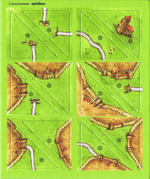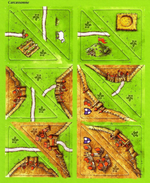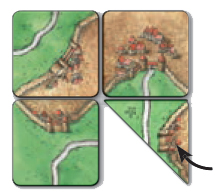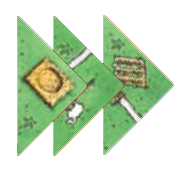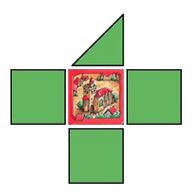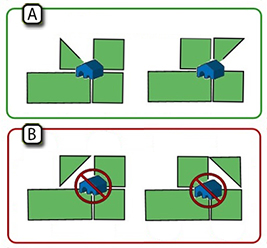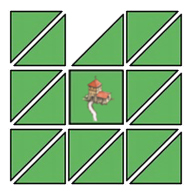Halb so wild (Erste Edition)
 |
You are reading the rules for this tile design. |  |
 | Read the following rules if your tiles look like this. |  |
| If your tiles have a different design, then choose a game from Spin-offs. |  |
WikiCarpedia authors' disclaimer
Die Designer von Halb so wild gingen ein Glücksspiel an, indem sie die Kartenform änderten, die sich völlig vom Spielkonzept unterscheidet. Wir sind weit davon entfernt zu beurteilen, ob dieses Experiment ein Erfolg war, aber wir fühlen uns verpflichtet, einige Aussagen zu machen.
Über WikiCarpedia verfolgen wir die Fakten und offiziellen Abklärungen, aber bei Halb so wild ist es fast unmöglich, da es vom Verlag HiG nicht unterstützt wird. Aufgrund seiner Einzigartigkeit ist es sogar schwierig, ein umfassendes Regelwerk zu erarbeiten, das Antworten auf alle offenen Fragen gibt, die im Zusammenspiel mit anderen Erweiterungen auftreten können.
Am Ende sei darauf hingewiesen, dass du beim Spielen von "Halb so wild" auf Situationen stoßen kannst, die hier nicht angesprochen werden, nicht weil wir diese Situationen nicht kennen, sondern weil wir keine Antworten in offiziellen Abklärungen finden konnten. Fühlen Sie sich in solchen Fällen frei, Hausregeln zu machen und Spaß zu haben!
Allgemeine Informationen und Kommentare
Halb so wild wurden ursprünglich in Halb so wild und Hans im Glück in 2014 veröffentlicht.
Die Halb so wild Mini-Erweiterung ist in zwei Versionen erhältlich. Eine Version ist in der Ausgabe 5/2014 des Magazins Spielbox (www.spielboxshop.de) verfügbar und diese Karten sind mit dem Fünfeck-Symbol gekennzeichnet. Die zweite Version war im Online-Shop von Hans im Glück erhältlich (www.cundco.de) und diese Karten sind mit dem "C"-Anhängersymbol gekennzeichnet. Daher ist es möglich, dass in den folgenden Beispielen Karten gezeigt werden, die nicht Teil des "Halb so wild"-Sets sind, das Sie besitzen können.
A later rerelease of this expansion was accompanied by a major revision of the clarifications provided in this page. In the latest rules, the tile grid has preference over individual tiles for different interactions. You may check the latest rules here.
Spielmaterial
- 12 neue dreieckige Karten (Spielbox: Halb so wild I)
- 12 neue dreieckige Karten (Cundco: Halb so wild II)
Regeln
Vorbereitung
Diese Mini-Erweiterung ist für bis zu 6 Spieler spielbar. Für mehr als 6 Spieler braucht man ein weiteres Set. Für das erste Spiel mit dieser Mini-Erweiterung empfehlen wir, alle Dreiecksfelder mit der Vorderseite nach unten zu mischen und jedem Spieler 2 zu geben. Die Spieler schauen sich ihre Karten an und bringen sie mit dem Gesicht nach unten an den Tisch vor ihnen zurück. Sobald die Spieler mit den neuen Karten besser vertraut sind, können sie die folgende Variante ausprobieren: Zu Beginn des Spiels werden alle Dreiecksfelder mit der Vorderseite nach oben auf den Tisch gelegt. Es wird ein Startspieler ermittelt. Beginnend mit dem Spieler, der die letzte Reihe ist, und gegen den Uhrzeigersinn, nimmt jeder einen Stein und legt ihn mit der Vorderseite nach unten vor sich hin. Alle Spieler nehmen dann auf die gleiche Weise eine zweite Karte. Somit hat jeder Spieler 2 Steine gewählt, die während des Spiels verwendet werden sollen. [1] [2] [3]
Mit der Ausnahme der neuen Regeln, die bei dieser Mini-Erweiterung verwendet werden, bleiben alle grundlegenden Carcassonne-Regeln unverändert.
Legen der Karten
On a player’s turn, he may play one of his 2 triangular tiles instead of drawing a normal tile. The triangular tiles are placed according to the usual rules; they must be placed so that at least one of the shorter sides of the tile touches a previously placed tile (not corner-to-corner only) or the longer side touches the longer side of another triangular tile.
In addition, any city, road, and farm segments must continue segments already in play. Note: The longer side of a triangular tile may never be placed against the side or a normal tile.
Tiles with expansion features: Some of the tiles from the CundCo version contain features from the ![]() Hills & Sheep and
Hills & Sheep and ![]() Crop Circles [4] [5] expansions. If you are not playing with those expansions along with Halflings, you may disregard those features.
Crop Circles [4] [5] expansions. If you are not playing with those expansions along with Halflings, you may disregard those features.
Hills: If a player places a triangular tile containing a Hill feature, and you are playing with the ![]() Hills & Sheep expansion, the player immediately draws a second (normal) tile, in accordance with the
Hills & Sheep expansion, the player immediately draws a second (normal) tile, in accordance with the ![]() Hills & Sheep rules, and places it face down under the triangular tile. The other “half” of the face down tile may be covered with another triangular tile at a later time. Both triangular tiles would then be considered part of the same Hill.
Hills & Sheep rules, and places it face down under the triangular tile. The other “half” of the face down tile may be covered with another triangular tile at a later time. Both triangular tiles would then be considered part of the same Hill.
Wertung
WICHTIGE HINWEISE
- Note 1 - Rule changes: After the original rules of 2014, the scoring rules for this expansion were changed in 10/2015.
- Original rules: a triangular tile scores as a normal landscape tile. If there are 2 triangular tiles in the same square “space”, they still only count as 1 tile (together) when scoring a feature: road, city or cloister.
- New rules: a triangular tile scores as a normal landscape tile. If there are 2 triangular tiles in the same square “space”, they will count as 1 tile each when scoring a feature: road, city or cloister.
- The scoring rules next reflect the new ones.
- Note 2 - Unclear basic rules: Due to the lack of clarity in the original rules and in later official clarifications up to date, triangular gaps pose a source of controversy affecting:
- Completed features: It is not clear in some cases whether a feature containing triangular gaps is considered completed and therefore can be scored: The original scoring rules (and later clarifications) only covered cloisters but no details have been provided for cities, roads or farms, where numerous questions have no official answer yet. [6] [7]
- Undefined interaction with other expansions: The landscape discontinuities triangular gaps originate affect the mechanics and/or the scoring of several other expansions. Only partial rule clarifications, if any, have been provided in order to mitigate some of the issues detected.
- No more clarifications will be provided by HiG. Based on the existing rules and clarification snippets, players try to extrapolate some house rules to address any issues they may encounter, but no consensus can be reached.
Scoring a feature [8]
Cloisters: When playing with Halflings, a cloister is considered to be completed even if one or more of its surrounding tiles are triangular tiles. In this case, a triangular tile scores as a normal landscape tile (1 point per tile surrounding the cloister.) If there are 2 triangular tiles in the same square “space”, each tile will count as 1 point when scoring a cloister. [9] [10]
Schlusswertung
The game ends immediately at the end of the turn in which the last normal land tile is placed. If any player still has any unplayed triangular tiles in front of them, they may no longer play them. Final scoring then takes place. [11]
Andere Erweiterungen
>> Allgemeine Überlegungen
- When a Halfling tile is beside a triangular gap, the Halfling tile counts as a single tile. When 2 Halfling tiles are side-by-side to create one square, they count as a single tile each. This is relevant when considering cloister scoring, city scoring, road scoring, Fairy protection, Dragon movement, the Plague token placement, the Flier movement, etc. (10/2014; updated 10/2015)
- Derzeit unterstützt HiG die Erweiterung von Halb so wild nicht und es werden keine weiteren Abklärungen vorgenommen. Die Kombination von Halb so wild mit anderen Erweiterungen geschieht dann "auf Risiko der Spieler". In solchen Fällen müssen Haus-Regeln vereinbart werden.
![]() Exp. 3 - The Princess & the Dragon - Fairy protection
Exp. 3 - The Princess & the Dragon - Fairy protection
![]() There is no official clarification regarding how the fairy behaves when placed on a Halfling tile beyond the general considerations above. As a result, we could consider the fairy only protects the triangular tile it is on, since it is a single tile.
There is no official clarification regarding how the fairy behaves when placed on a Halfling tile beyond the general considerations above. As a result, we could consider the fairy only protects the triangular tile it is on, since it is a single tile.
>> Burgfräulein und Drache - Bewegen des Drachens
- Es gibt keine offizielle Klärung, wie sich der Drache auf Halb so wild Karten über die oben genannten allgemeinen Überlegungen hinaus bewegt.
- Notes:
- Rule clarification: When moving the dragon, triangle tiles are considered individual tiles.
- Open question: Can it be assumed that the dragon can move past a triangular gap? Clarifications for other expansions such as
 The Plague (see below), may lead to a positive conclusion but there is no official confirmation.
The Plague (see below), may lead to a positive conclusion but there is no official confirmation.
>> Der Turm - Turm Reichweite
![]() There is no official clarification regarding how tower range is calculated involving Halflings beyond the general considerations above.
There is no official clarification regarding how tower range is calculated involving Halflings beyond the general considerations above.
- Notes:
- Rule clarification: When computing the tiles affected by the tower range, triangle tiles are counted as individual tiles.
- Open question: Can it be assumed that triangular gaps, if any present, are ignored in the tower range calculation? Clarifications for other expansions such as
 German/Dutch and Belgian Monasteries (see below), may lead to a positive conclusion but there is no official confirmation.
German/Dutch and Belgian Monasteries (see below), may lead to a positive conclusion but there is no official confirmation.
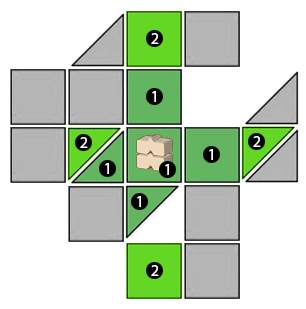 Example: The picture shows the tiles affected by the tower using different shades of green to identify tiles within range 1 and range 2. The range stretch takes into account triangular tiles independently and skips any triangular gap in the way. Skipping triangular gaps is not officially confirmed in an explicit way.
Example: The picture shows the tiles affected by the tower using different shades of green to identify tiles within range 1 and range 2. The range stretch takes into account triangular tiles independently and skips any triangular gap in the way. Skipping triangular gaps is not officially confirmed in an explicit way.
>> Abtei und Bürgermeister - Teil 1: Legen der Abtei und Wertung
![]() An abbey can be placed if a Halfling tile is on one of the edges, even if there is a Halfling gap on one of the edges. See the clarification images below. (3/2015)
An abbey can be placed if a Halfling tile is on one of the edges, even if there is a Halfling gap on one of the edges. See the clarification images below. (3/2015)
![]() There is no official explicit confirmation on how abbeys are scored when interacting with Halflings beyond ruling for cloisters.
There is no official explicit confirmation on how abbeys are scored when interacting with Halflings beyond ruling for cloisters.
- Notes:
- House rule: The scoring of an abbey follows the official rules defined for cloisters.
![]() Exp. 5 - Abbey & Mayor - Part 2: Barn placement
Exp. 5 - Abbey & Mayor - Part 2: Barn placement
![]() A barn can be placed as long as 4 tiles touch at the intersection, even if there is one or more Halfling tiles. (10/2015)
A barn can be placed as long as 4 tiles touch at the intersection, even if there is one or more Halfling tiles. (10/2015)
![]() Additionally the barn placement rules have been updated as follows: The base ground for the barn has to be stable so it cannot wiggle. This means that under the barn:
Additionally the barn placement rules have been updated as follows: The base ground for the barn has to be stable so it cannot wiggle. This means that under the barn:
- all tiles have to touch each other in the middle;
- no quarter is empty in the middle; and
- all tiles have farm in the middle for the placement of the barn.
- See the following examples involving Halfling tiles and double-size tiles (see
 Castles in Germany). (04/2016)
Castles in Germany). (04/2016)
- Note: The rules update from 10/2015 overrides, in certain cases, the original four-tile intersection requirement for the placement of the barn defined originally for square tiles. This happens in favor of providing stability to the barn when tiles with other geometries are considered, as can be seen in the examples involving double-size tiles and/or triangle tiles.
![]() Exp. 5 - Abbey & Mayor - Part 3: Barn scoring
Exp. 5 - Abbey & Mayor - Part 3: Barn scoring
![]() There is no official rules on how barns interact with the landscape discontinuities that can be generated by Halflings.
There is no official rules on how barns interact with the landscape discontinuities that can be generated by Halflings.
- Notes:
- Open question: Can triangular gaps be considered as holes in the farm landscape? If so, certain tile configuration could lead to the creation of separate farms that converge at an intersection, some of them eligible for barn placement. There is no official rule or clarification stating how triangle gaps affect farms.
- Open question: When placed on a farm convergence intersection, does the barn connect these separate farms to form one single farm? There is no official rule or clarification on this point, but the official rules for barn placement were designed to ensure it was always placed on one single farm.
- House rule 1: Triangular gaps could be considered as limits of the landscape (the same as square holes), so several farms can converge at a tile intersection and be disconnected.
- House rule 2: The barn, when placed (legally) at a point where several farms meet, they should be considered as merged into one single farm. This seems reasonable as the placement of additional Halfling tiles filling the gaps would not alter the previous situation but resolve to materialize the assumed landscape continuity. Additionally, all the barn scoring rules would apply as usual.
![]() Heretics and Shrines - Shrine scoring
Heretics and Shrines - Shrine scoring
![]() There is no official explicit confirmation on how shrines are scored when interacting with Halflings beyond ruling for cloisters.
There is no official explicit confirmation on how shrines are scored when interacting with Halflings beyond ruling for cloisters.
- Notes:
- House rule: The scoring of a shrine follows the official rules defined for cloisters.
![]() Exp. 8 - Bridges, Castles & Bazaars - Bridge placement
Exp. 8 - Bridges, Castles & Bazaars - Bridge placement
- Es gibt keine offizielle Klärung wie Brücken mit Halb-so-wild verwendet werden.
- Notes:
- Open question: Can a bridge be placed on a square space only occupied by one to two Halflings?
- House rule: A house rule could allow the placement of the bridge only if it stands on a stable base ground following the lead of the clarifications for the
 Abbey & Mayor's barn (see above). This would mean that bridges could be deployed on a place occupied by a square tile or two Halflings, but not if occupied by one single Halfling.
Abbey & Mayor's barn (see above). This would mean that bridges could be deployed on a place occupied by a square tile or two Halflings, but not if occupied by one single Halfling.
>> Gluggeräte - Flieger Reicheite und setzen Des Gefolgsmanns
- Es gibt keine offizielle Klarstellung darüber, wie die Fliegerdistanz und die Landefälle behandelt werden, wenn es sich um Halb so wild handelt, die über die oben genannten allgemeinen Überlegungen hinausgehen.
- Notes:
- Rule clarification: When computing the Flier distance, triangle tiles are counted as individual tiles.
- Open question: Can it be assumed that triangular gaps, if any present, are ignored and only the Halfling tiles are taken into account for computing the Flier distance? Clarifications for other expansions such as
 German/Dutch and Belgian Monasteries (see below), may lead to a positive conclusion but there is no official confirmation. See the examples below following this assumption.
German/Dutch and Belgian Monasteries (see below), may lead to a positive conclusion but there is no official confirmation. See the examples below following this assumption.

- Open question: How to proceed if the Flier, following a diagonal trajectory, has to land on a square space occupied by two triangle tiles whose long side is aligned with such trajectory? No official clarification exists. A house rule may dictate that the player may choose a feature of either tile.
 Example 5: This image shows how triangle tiles are considered when calculating the Flier distance for a diagonal trajectory. This particular case, due to the orientation of the Halflings, has two possible tiles with distance 1. A house rule could determine that if a Flier had to land with such a distance, he/she could choose either of them as the landing tile.
Example 5: This image shows how triangle tiles are considered when calculating the Flier distance for a diagonal trajectory. This particular case, due to the orientation of the Halflings, has two possible tiles with distance 1. A house rule could determine that if a Flier had to land with such a distance, he/she could choose either of them as the landing tile.
- House rule: A house rule could define that the Flier distance is calculated taking into account square tiles, square gaps and triangular tiles. If the landing place contains two triangular tiles with the same distance, the player will choose either of them at his/her convenience.
![]() The Plague - Plague spreading
The Plague - Plague spreading
![]() A single triangle hole does not prevent the The Plague from spreading in that direction. (10/2015)
A single triangle hole does not prevent the The Plague from spreading in that direction. (10/2015)
>> Deutsche/Niederländische und Belgische Klöster - Abt Wertung
![]() A triangle tile takes the place of a regular landscape tile. Thus, a single triangle hole in the map does not stop the row or column for scoring for
A triangle tile takes the place of a regular landscape tile. Thus, a single triangle hole in the map does not stop the row or column for scoring for ![]() German and Dutch/Belgian Monasteries's abbot. Only a hole of a complete regular landscape tile interrupts the row or column. (3/2015)
German and Dutch/Belgian Monasteries's abbot. Only a hole of a complete regular landscape tile interrupts the row or column. (3/2015)
![]() The following image shows how triangle tiles are considered individually when scoring an abbot placed on a German Monastery. It can be seen that triangular gaps are ignored.
The following image shows how triangle tiles are considered individually when scoring an abbot placed on a German Monastery. It can be seen that triangular gaps are ignored.
 Example: RED will get 1 + 2 + 2 + 3 + 1 = 9 points from scoring his/her abbot:
Example: RED will get 1 + 2 + 2 + 3 + 1 = 9 points from scoring his/her abbot:- 1 point from the monastery tile
- 2 points from the vertical column above the monastery tile (1 point coming from a triangular tile)
- 2 points from the vertical column below the monastery tile (1 point coming from a triangular tile)
- 3 points from the horizontal row to the left of the monastery tile (2 points coming from triangular tiles)
- 1 point from the horizontal row to the right of the monastery tile formed by a single triangular tile
>> Burgen in Deutschland - Fertigstellung einer Deutschen Burg
![]() There is no official clarification regarding how German Castles interact with Halflings beyond the general considerations above.
There is no official clarification regarding how German Castles interact with Halflings beyond the general considerations above.
- Note:
- House rule: A German Castle could be considered completed if totally surrounded by square tiles and spaces occupied by one or two Halflings, following the official ruling for cloisters.
- House rule: The scoring of a German Castle could be 2 points for the German Castle tile plus 1 point per surrounding tile (square or triangular), taking into account the official rules for cloisters.
![]() Little Buildings - Area affected by Little Building
Little Buildings - Area affected by Little Building
![]() There is no official clarification regarding how Little Buildings interact with Halflings beyond the general considerations above.
There is no official clarification regarding how Little Buildings interact with Halflings beyond the general considerations above.
- Note:
- House rule: A Little Building only affects the Halfling tile it is placed on, not affecting the other Halfling, if any, sharing the same square space. This consideration comes from the fact that a Halfling counts as a single tile and Little Building affects a whole tile. [12]
Community Regeln
>> Introduction
This section provides a set basic unofficial community rules to navigate through the the pitfalls found when playing Halflings. They are not official but will help solve some of the issues derived from the lack of rules for the expansion itself and the interactions with other expansions.
The Carcassonne base rules define the behavior and interactions based on a square grid occupied by tiles and holes. The problems with Halflings arise from the lack of a full set of rules that cover all the cases when a square space is occupied by a triangular tile (that leaves a triangular gap) or two triangular tiles.
Triangular tiles are considered as individual tiles, and this affects several aspects of the basic game mechanics. However, triangular gaps become a serious generator of continuous conflict. The incomplete clarifications to the Halflings rules leave behind a field full of pitfalls and a few hints that players try to squeeze and analyze looking for answers that will never be officially confirmed by HiG.
With this context, after detailing in the previous section the rules, clarifications, open questions and some house rules for the interactions between Halflings and other expansions, we'll try to put together some basic remarks that could serve as a short guideline that distill the aforementioned material.
>> Rationale
Two principles serve as a cornerstone:
- Triangular tiles are counted as individual tiles
- Triangular gaps show two different behaviors depending on the context:
- A triangular gap can behave as a hole, for example, in a feature
- A triangular gap can be ignored, for example, when moving a figure
The table below sums up the different contexts where issues arise and provide an appropriate ruling. But first let's list the game contexts taken into consideration:
- Landscape Continuity: how triangular tiles and gaps affect various features, such as a farm or a city
- Feature Placement: how triangular tiles and gaps affect the placement of a feature, such as an abbey
- Feature Completeness: how triangular tiles and gaps affect a feature to be considered as completed, such as a city or a cloister
- Featuring Scoring: how triangular tiles and gaps affect the scoring of a feature, such as a German Monastery
- Figure Placing/Movement: how figure mechanics are affected by triangular tiles and gaps; for example, the dragon
- Action Range / Trajectory calculation: how action ranges for a tower or the trajectory of a flier are affected by triangular tiles and gaps
>> How to deal with triangular tiles and gaps
Important Reminder: Triangular tiles are considered as individual tiles. Bear this in mind when placing followers or other figures, and when scoring features.
The following table summarizes the community rules for conflicting scenarios.
| Triangular Tiles and Triangular Gap Behavior | ||||||
|---|---|---|---|---|---|---|
| Gap Behavior | Landscape Continuity | Feature Placement | Feature Completeness | Feature Scoring | Placing / Moving a Figure | Action range / Trajectory Calculation |
| A hole | Farm (1) | Farm | Bridge | |||
| City, Road | City, Road | City, Road | ||||
| Ignored | Abbey (2) | Cloister, Shrine, Abbey, Garden, German Monastery (monk) | Cloister, Shrine, Abbey, Garden, German Monastery (monk) | Dragon | Tower, Flier (3) | |
| German Monastery (abbot) | ||||||
| Flea Token | ||||||
- Notes:
- (1) - Farm continuity: The placement of a barn can alter farm continuity if it merges separate farms touching at intersection it is placed on
- (2) - Abbey placement: An eligible place for an abbey requires its four sides not to be square holes
- (3) - Flier landing: if the Flier has to land on a square space with two triangular tiles side by side when following a diagonal trajectory (i.e., both share the same distance), the player has to choose one of them at his/her convenience as landing tile
>> Wie wird mit Gutshöfen umgegangen
Additionally, these are the community rules for the barn:
- Placement Rules: It is placed on the intersection of four square corners where all quarters are partially or fully occupied and meet in the middle. That is, the barn is always placed on a stable base ground. At an intersection can meet from 3 (involving a double-sized tile) up to 8 tiles (all of them Halflings), and all of them should have only farmland to allow the barn to be placed.
- Landscape Continuity: The barn will merge any farms touching at the intersection where it is placed. Thus, farm scoring will happen as usual. Any additional triangular tile placed in any gaps left under the barn will materialize the assumed farm continuity.
>> How to deal with bridges
A bridge could be placed over two Halflings occupying one square space if both ends are in a field. The bridge will also have to comply with the other usual placement rules.
The following considerations are also important, since a bridge is placed across two tiles:
- Follower placement: Any follower placed on the bridge has to be clearly on one of its halves, that is, assigned to one of the Halflings underneath. This is necessary, for example, if playing with the dragon or the Plague in order to know when a follower on a bridge may be affected.
- Scoring: The bridge will count as 1 road segment per Halfling underneath, that is, two tiles in this case. [13]
>> Wie wird mit Häusern umgegangen
Little Buildings placed on a Halfling tile will affect only that triangular tile. If another Halfling tile shares the same square space, it will not be affected.
Karten Verteilung
Halb so wild I (Spielbox)
Halb so wild II (Cundco)
Referenzen
Für Lizenzen und Erklärungen besuche Icons page.
- ↑
 Wenn Sie mit weniger als 6 Spielern spielen, sollte jeder Spieler immer noch 2 Karten nehmen. (3/2015)
Wenn Sie mit weniger als 6 Spielern spielen, sollte jeder Spieler immer noch 2 Karten nehmen. (3/2015)
- ↑
 Als Alternative kann jeder Spieler, wenn er mit weniger als 6 Spielern spielt, so lange Karten ziehen oder wählen, bis die Karten aufgebraucht sind und jeder Spieler die gleiche Anzahl von Karten hat (z.B. 4 Spieler erhalten jeweils 3). (3/2015)
Als Alternative kann jeder Spieler, wenn er mit weniger als 6 Spielern spielt, so lange Karten ziehen oder wählen, bis die Karten aufgebraucht sind und jeder Spieler die gleiche Anzahl von Karten hat (z.B. 4 Spieler erhalten jeweils 3). (3/2015)
- ↑
 Beim Spielen mit beiden Halb so wild I und II gibt es keinen Konsens über die Anzahl der Steine pro Spieler. Es handelt sich technisch gesehen um zwei separate Mini-Erweiterungen, so dass die Spieler aus jedem Satz zwei nehmen können.
Alternativ, weil sie die gleichen Regeln haben und damit funktional eine größere Erweiterung sind, Spieler konnten insgesamt 2 Halblingstapel nehmen. (3/2015)
Beim Spielen mit beiden Halb so wild I und II gibt es keinen Konsens über die Anzahl der Steine pro Spieler. Es handelt sich technisch gesehen um zwei separate Mini-Erweiterungen, so dass die Spieler aus jedem Satz zwei nehmen können.
Alternativ, weil sie die gleichen Regeln haben und damit funktional eine größere Erweiterung sind, Spieler konnten insgesamt 2 Halblingstapel nehmen. (3/2015)
- ↑
 The sheep on the tile counts as a "permanent" sheep token every time that a shepherd on the associated farm scores his sheep. (11/2014)
The sheep on the tile counts as a "permanent" sheep token every time that a shepherd on the associated farm scores his sheep. (11/2014)
- ↑
 The circular crop circle on the Halfling tile is a Joker. This means that the player who places this tile can decide if he or she wants to treat it as a shield, a pitchfork, or a club. (11/2014)
The circular crop circle on the Halfling tile is a Joker. This means that the player who places this tile can decide if he or she wants to treat it as a shield, a pitchfork, or a club. (11/2014)
- ↑
 The following examples show the consequences of the poorly-defined rules as there are cases where no official ruling dictates if a city is completed.
The following examples show the consequences of the poorly-defined rules as there are cases where no official ruling dictates if a city is completed.
 Example 2: The presence of a triangular gap in this city creates a ruling conflict:
Example 2: The presence of a triangular gap in this city creates a ruling conflict:- Base game rules state this city is not completed as it contains a gap;
- On the other hand, Halflings rules do not treat a half-tile gap as a proper one, so the city could be considered completed.
Similar cases can arise when deciding whether a road is completed if interrupted by a triangular gap.
- ↑
 Triangular gaps in farms are also an open question: It is not defined if the break the landscape and therefore can separate farms.
Triangular gaps in farms are also an open question: It is not defined if the break the landscape and therefore can separate farms.
- ↑
 The scoring of a completed city or road will follow the normal rules and any triangular tiles will be counted as a regular tile.
The scoring of a completed city or road will follow the normal rules and any triangular tiles will be counted as a regular tile.
- ↑
 Generalizing the rule for square tiles to include Halfling tiles, cloisters will be completed when the space with the cloister and the eight adjacent spaces are occupied by at least one tile no matter if it is a square of Halfling tile. The presence of triangular gaps in these spaces will not be taken into consideration.
Generalizing the rule for square tiles to include Halfling tiles, cloisters will be completed when the space with the cloister and the eight adjacent spaces are occupied by at least one tile no matter if it is a square of Halfling tile. The presence of triangular gaps in these spaces will not be taken into consideration.
- ↑
 The following image illustrates the scoring of a completed cloister with Halfling tiles in its surroundings.
The following image illustrates the scoring of a completed cloister with Halfling tiles in its surroundings.
- ↑
 Farm scoring is affected by the landscape continuity. There are cases not covered by the rules or later clarifications.
Farm scoring is affected by the landscape continuity. There are cases not covered by the rules or later clarifications.
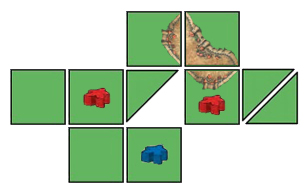 Example: It is not defined if RED and BLUE are on the same farm, as it is not clear whether the triangular gap in the picture interrupts the farm or not. The players will have to decide a ruling and the outcomes will be totally different when scoring the city in this example:
Example: It is not defined if RED and BLUE are on the same farm, as it is not clear whether the triangular gap in the picture interrupts the farm or not. The players will have to decide a ruling and the outcomes will be totally different when scoring the city in this example:- Case 1 - The farms are connected: If so, RED has the majority of the farm and gets 3 points for the city. BLUE gets 0 points.
- Case 2 - The farms are not connected: In this case, RED and BLUE share the farm on the left and will score 3 points each for it. Additionally, RED is alone in the farm on the right and will score 3 points for it.
- ↑
 With the old rules, a Little Building on a Halfling tile would have affected both triangular tiles sharing the same square space, since they are counted as one single tile for scoring.
With the old rules, a Little Building on a Halfling tile would have affected both triangular tiles sharing the same square space, since they are counted as one single tile for scoring.
- ↑
 This is required for the sake of consistency. If the road connected to the bridge loops back and passes under the same bridge, the road underneath would count as two tiles and the one passing over the bridge should have the same number of tiles too. In a nutshell, the number of tiles represented by a bridge has to be aligned with the number of tiles it occupies as each tile is counted once when scoring a road.
This is required for the sake of consistency. If the road connected to the bridge loops back and passes under the same bridge, the road underneath would count as two tiles and the one passing over the bridge should have the same number of tiles too. In a nutshell, the number of tiles represented by a bridge has to be aligned with the number of tiles it occupies as each tile is counted once when scoring a road.


